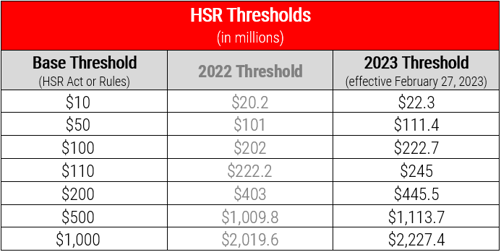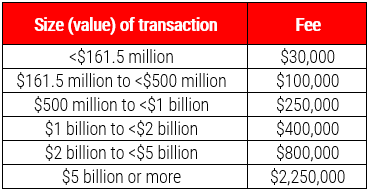The Federal Trade Commission (FTC) has announced new, higher premerger notification thresholds. The new minimum size-of-transaction threshold will be $111.4 million.
The FTC simultaneously announced implementation of the new filing fee structure set forth in the Merger Filing Fee Modernization Act of 2022 (contained in the Consolidated Appropriations Act of 2023). The new six-tiered fee structure includes a filing fee of $2.25 million for transactions valued at $5 billion or more.
Both the threshold adjustments and the new filing fee structure take effect February 27, 2023. An important distinction is that the applicable HSR thresholds are those in effect when you close, and the applicable HSR filing fees are those in effect when you file.
2023 HSR Thresholds
Under the 2000 amendments to the Hart-Scott-Rodino (HSR) Act, 15 U.S.C. 18a, the jurisdictional thresholds are adjusted annually to reflect changes in nominal (non-inflation-adjusted) gross national product (GNP).
The increase in the minimum size-of-transaction threshold to $111.4 million from the 2022 threshold of $101 million is the largest such increase in both dollar and percentage terms since annual adjustments began in 2005.
The annual adjustments pursuant to the 2000 HSR Act amendments have thus resulted in the minimum size-of-transaction threshold more than doubling from the $50 million threshold established by those amendments (which increased the original $15 million threshold that was established in 1976).
Adjustments to size-of-transaction thresholds
Transactions that are never reportable: A transaction that results in holdings of $111.4 million or less will not require HSR notification.
Transactions that are always reportable: At the other end of the size spectrum, a transaction that results in holdings of more than $445.5 million will trigger HSR notification and waiting requirements unless an exemption from filing applies.
Transactions that may be reportable: For transactions resulting in holdings falling between these two size-of-transaction thresholds (that is, greater than $111.4 million but no greater than $445.5 million), whether HSR applies depends on whether both parties meet the size-of-person thresholds. (Note that these thresholds apply to the size of the parties and not merely to the size of the acquiring entity and the acquired entity, so it is necessary to look to the ultimate parent entity of each and include all entities controlled by it.)
Adjustments to size-of-person thresholds
The adjusted size-of-person thresholds for 2023 are $22.3 million and $222.7 million, meaning that acquisitions resulting in holdings of greater than $111.4 million but no greater than $445.5 million will not require HSR notification unless one person has total assets or annual net sales of $22.3 million or more and the other person $222.7 million or more. (Note that, additionally, if the acquired person is not engaged in manufacturing, it must have annual net sales of $222.7 million or total assets of $22.3 million.)
What other thresholds change?
The HSR Rules (16 CFR parts 801-803) provide several exemptions that contain dollar value limitations described by the parenthetical “(as adjusted).” Those limitations (for example, the nexus with commerce limitations for the exemptions for acquisitions of foreign assets (16 CFR 802.50) and acquisitions of voting securities of a foreign issuer (16 CFR 802.51)) will also be adjusted upward.
The HSR Rules also provide “notification thresholds” for voting securities acquisitions (see 16 CFR 801.1(h)), setting forth levels of holdings that would require another HSR notification. (Note, however, that once the 50 percent level is reached, no additional notification is required.) As the dollar values for these notification thresholds are set forth with the parenthetical “(as adjusted),” they will similarly be adjusted upward.

New Filing Fees
The Merger Filing Fee Modernization Act of 2022 established the six-tiered fee structure that the FTC is implementing for transactions filed on or after February 27, 2023.


Previously (since 2001), there were three tiers of filing fees ($45,000, $125,000, and $280,000) based on the size of the transaction.
Thus, under the new fee requirements, relatively larger transactions will be subject to significantly higher filing fees than previously. For example, a transaction valued at $5 billion or more will be subject to a filing fee of $2.25 million instead of $280,000. For some smaller transactions, the filing fee will be reduced from $45,000 to $30,000 or from $125,000 to $100,000.
Beginning in Fiscal Year 2024, the filing fee tiers will be adjusted annually to reflect changes in GNP. In addition, the fees applicable to each tier will be adjusted annually based on changes in the consumer price index. Previously, while the points at which the different fee levels applied were required to be adjusted annually to reflect changes in GNP, the fees themselves were not adjusted.











